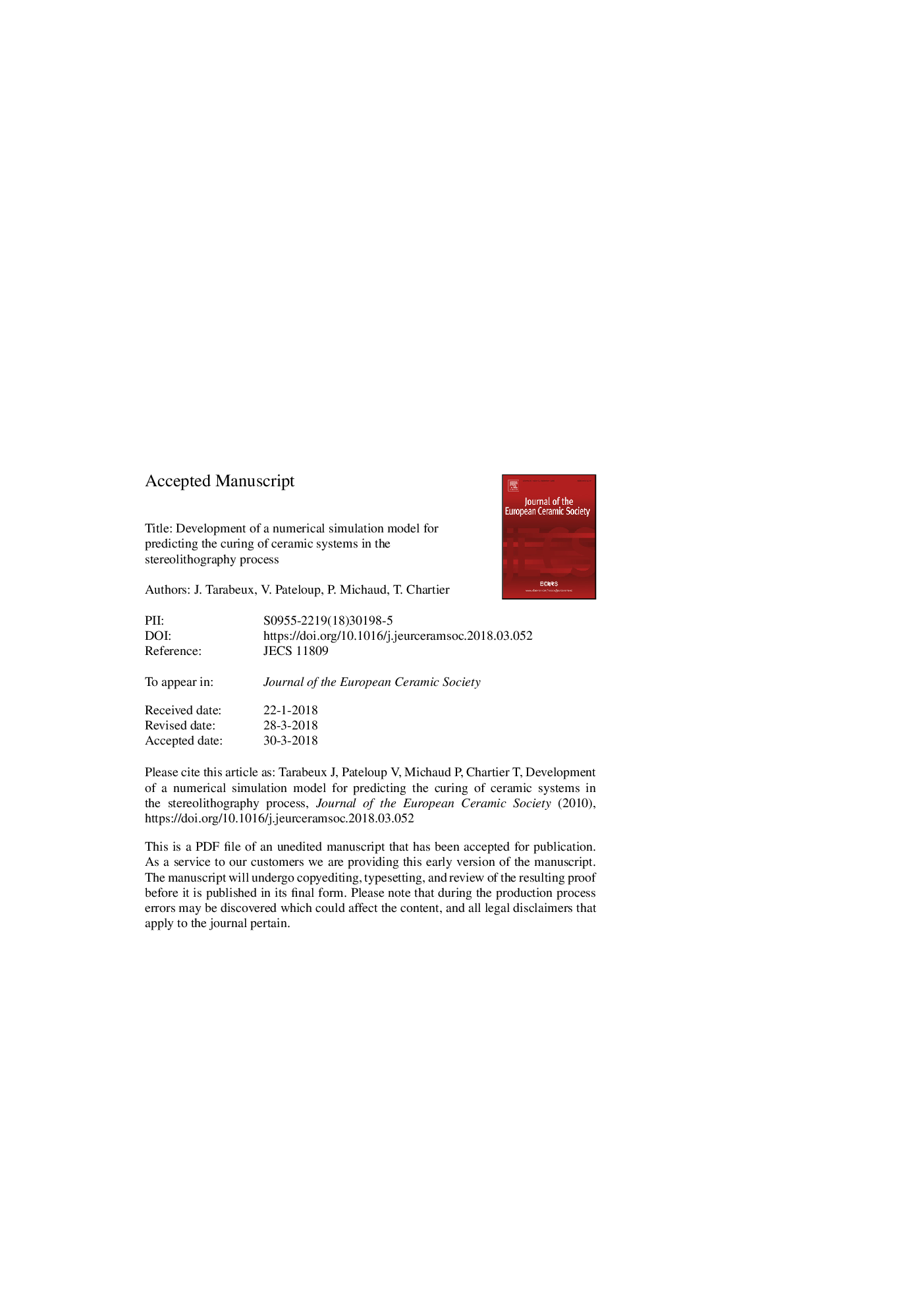| کد مقاله | کد نشریه | سال انتشار | مقاله انگلیسی | نسخه تمام متن |
|---|---|---|---|---|
| 7898061 | 1510130 | 2018 | 21 صفحه PDF | دانلود رایگان |
عنوان انگلیسی مقاله ISI
Development of a numerical simulation model for predicting the curing of ceramic systems in the stereolithography process
ترجمه فارسی عنوان
توسعه یک مدل شبیه سازی عددی برای پیش بینی ترمیم سیستم های سرامیکی در فرآیند استریولیتوگرافی
دانلود مقاله + سفارش ترجمه
دانلود مقاله ISI انگلیسی
رایگان برای ایرانیان
کلمات کلیدی
تولید افزودنی، استریولیتوگرافی، پخت، پراکندگی، مدل شبیه سازی،
ترجمه چکیده
کنترل اجزای سبز سرامیکی تولید شده توسط استریولیتوگرافی یک نگرانی مرکزی از صنعت تولید افزودنی سرامیک است. حضور ذرات سرامیکی در سیستم فتوکپی پتانسیل موجب پدیده پراکندگی پرتوهای اشعه ماوراء بنفش می شود و روند پلیمریزاسیون را مختل می کند. این مطالعه بر توسعه یک مدل شبیه سازی عددی فرآیند پخت، با توجه به پدیده پراکندگی تمرکز دارد. این مقاله هر مرحله از توسعه مدل شبیه سازی عددی را ارائه می دهد، پشتیبانی و در نهایت با استفاده از آزمایش در یک عنصر آلومینای فت پلیمری قابل استفاده است. اولا، مدل شبیه سازی عددی ارائه شده است. سپس، یک آزمایشگاه مربع گرام-لاتین برای کاهش تعداد آزمایشات انجام می شود. پس از آن، پارامترهای وابسته به ماده توسط شبیه سازی و اندازه گیری های تجربی شناسایی می شوند و یک قانون پراکندگی پیشنهاد شده است. در نهایت، مدل شبیه سازی اجازه می دهد تا به راحتی و با دقت شبیه سازی عرض پخت و عمق درمان. این همچنین تجسم توزیع قرار گرفتن در معرض و پدیده پراکندگی را فراهم می کند.
موضوعات مرتبط
مهندسی و علوم پایه
مهندسی مواد
سرامیک و کامپوزیت
چکیده انگلیسی
The control of ceramic green parts dimensions produced by stereolithography is a central concern of the ceramic additive manufacturing industry. The presence of ceramic particles within the photopolymerizable system induces UV-laser beam scattering phenomenon, disrupting the polymerization process. This study focuses on the development of a numerical simulation model of the curing process, considering the scattering phenomenon. This paper presents each stages of the development of the numerical simulation model, supported and finally validated by experimentation on a commercial photopolymerizable alumina paste. Firstly, the numerical simulation model is presented. Then, a Greco-Latin square design of experiments is conducted to reduce the number of experiments. Subsequently, material-dependent parameters are identified through simulations and experimental measurements, and a scattering law is proposed. Finally, the simulation model enables to simulate easily and with accuracy the cure widths and the cure depth. It also provides visualization of the exposure distribution and the scattering phenomenon.
ناشر
Database: Elsevier - ScienceDirect (ساینس دایرکت)
Journal: Journal of the European Ceramic Society - Volume 38, Issue 11, September 2018, Pages 4089-4098
Journal: Journal of the European Ceramic Society - Volume 38, Issue 11, September 2018, Pages 4089-4098
نویسندگان
J. Tarabeux, V. Pateloup, P. Michaud, T. Chartier,
